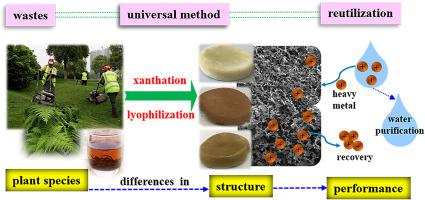Chemosphere ( IF 8.1 ) Pub Date : 2020-11-30 , DOI: 10.1016/j.chemosphere.2020.129129 Nana Wang , Yuyin Qiu , Kaimei Hu , Chujie Huang , Junsong Xiang , Hui Li , Jinfeng Tang , Jianqiao Wang , Tangfu Xiao

|
The continuous production of plant wastes and heavy metal pollution of waters have become widespread unavoidable challenges. Reutilization of plant wastes to treat toxic metal-contaminated water is an eco-friendly way to simultaneously solve these problems. Herein, three cake-like biosorbents were synthesized from tea waste, trimmed lawn grass and Nephrolepis cordifolia leaves through a one-step xanthation modification method combined with lyophilization, respectively. The plant species affected the appearance, structure and mechanical strength of the biosorbents due to the different contents of hydrocarbons and inorganic substances, which influenced the gel-like degree and thus the ability of the particles to pack between water molecules. The maximum adsorption capacities of the modified materials for Pb(II), Cu(II) and Cd(II) were 247.20, 85.80 and 265.31 mg/g, respectively, far higher than those of the original wastes, and the adsorption was selective. These results were mainly attributed to newly introduced –(C S)–S–Na groups, which triggered ion exchange, complexation and microprecipitation between heavy metal ions and functional groups. As-prepared biosorbents owned an excellent regenerability, which contributed to recovery heavy metals. The physicochemical properties and adsorption performances of the modified materials indicated that xanthation is a universal modification method suited to different plant biomasses with great potential to purify heavy metal-contaminated water. These biosorbents with excellent separability and regenerability might be promising for continuous-flow sewage treatment.
S)–S–Na groups, which triggered ion exchange, complexation and microprecipitation between heavy metal ions and functional groups. As-prepared biosorbents owned an excellent regenerability, which contributed to recovery heavy metals. The physicochemical properties and adsorption performances of the modified materials indicated that xanthation is a universal modification method suited to different plant biomasses with great potential to purify heavy metal-contaminated water. These biosorbents with excellent separability and regenerability might be promising for continuous-flow sewage treatment.
中文翻译:

从植物生物质中一步一步合成蛋糕状生物吸附剂,以有效去除和回收重金属:植物种类的影响和黄嘌呤的作用
植物废料的连续生产和水的重金属污染已成为普遍不可避免的挑战。重新利用植物废料处理有毒金属污染的水是一种同时解决这些问题的环保方法。在此,从茶渣,修剪过的草坪草和野菊(Nephrolepis cordifolia)合成了三种蛋糕状生物吸附剂。通过一步一步的黄嘌呤修饰方法与冻干相结合而形成叶子。由于碳氢化合物和无机物含量的不同,植物物种影响了生物吸附剂的外观,结构和机械强度,从而影响了凝胶状程度,从而影响了颗粒在水分子之间的堆积能力。改性材料对Pb(II),Cu(II)和Cd(II)的最大吸附容量分别为247.20、85.80和265.31 mg / g,远高于原始废物的吸附容量,并且具有选择性吸附。这些结果主要归因于新引入的-(C S)–S–Na基团,引发重金属离子和官能团之间的离子交换,络合和微沉淀。制备的生物吸附剂具有出色的可再生性,有助于回收重金属。改性材料的理化性质和吸附性能表明,黄药化是一种适用于不同植物生物质的通用改性方法,具有提纯重金属污染水的巨大潜力。这些具有出色的可分离性和可再生性的生物吸附剂可能对于连续流污水处理很有希望。
S)–S–Na基团,引发重金属离子和官能团之间的离子交换,络合和微沉淀。制备的生物吸附剂具有出色的可再生性,有助于回收重金属。改性材料的理化性质和吸附性能表明,黄药化是一种适用于不同植物生物质的通用改性方法,具有提纯重金属污染水的巨大潜力。这些具有出色的可分离性和可再生性的生物吸附剂可能对于连续流污水处理很有希望。











































 京公网安备 11010802027423号
京公网安备 11010802027423号